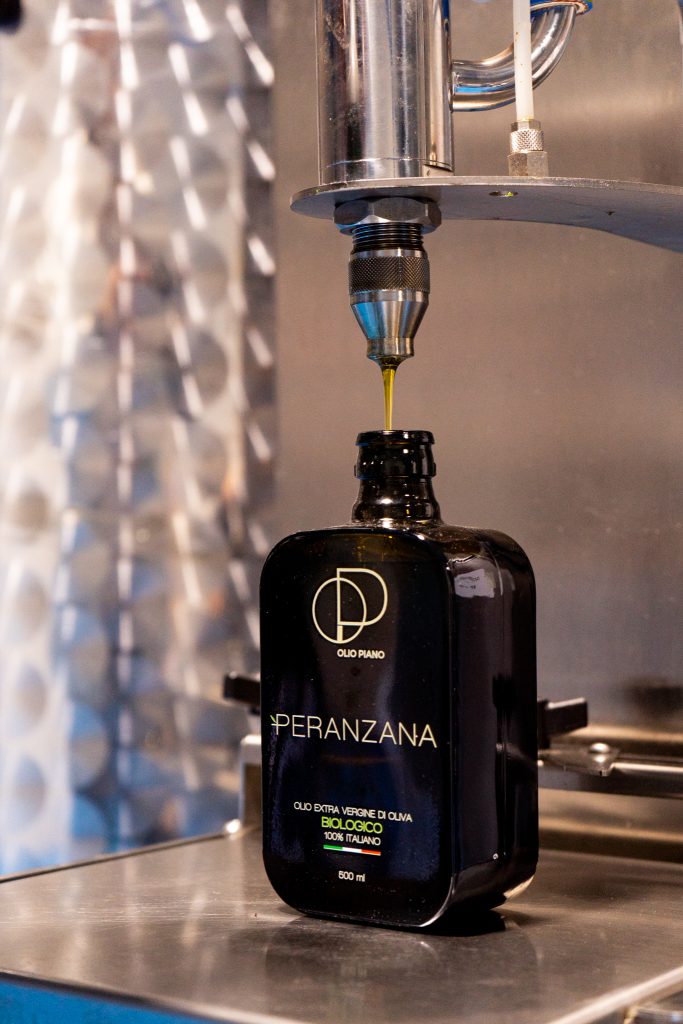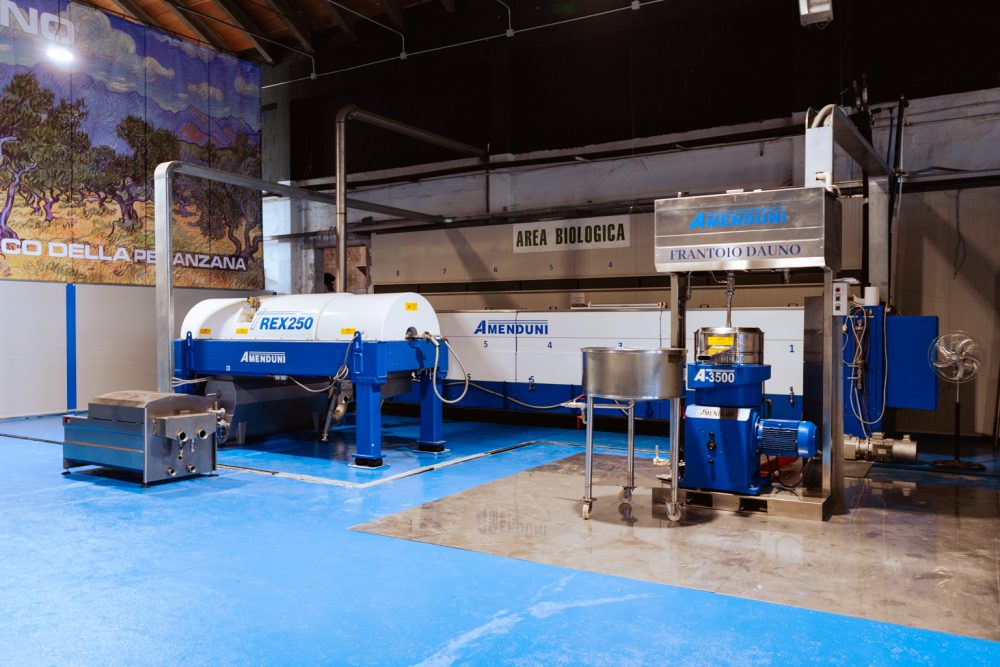The production of a high-quality extra virgin olive oil starts with a long and delicate process, in which every stage—from the care of the olive groves to bottling—affects the final aroma and flavor profile. Attention to detail at every step is essential: only through precise, respectful processing of the raw material can an oil be obtained that preserves the freshness and richness of freshly picked olives.
Indice
Olive harvesting: quality starts from the raw material
The quality of extra virgin olive oil begins in the field, with healthy, intact olives, free from parasites and harvested at the right time. Each variety has its own characteristics—shape, size, pulp-to-pit ratio—that influence yield and aromatic profile.
The ideal stage for harvesting is veraison, when the drupes begin to change color and reach their highest polyphenol and fruity fragrance content. Picking at this stage results in an oil rich in antioxidants, with bitter and spicy notes and greater stability over time.
Olives should be hand-picked or harvested using light mechanical means, avoiding those that have fallen to the ground, and transported in ventilated crates to prevent bruising and fermentation. Finally, they must be milled within 6–12 hours (never beyond 24) to preserve aromas, freshness, and nutritional value.
Milling: breaking the olives to release the green gold
After optional defoliation and washing, the olives undergo milling (or crushing)—the heart of the extraction process. This first stage consists of breaking the olives to rupture the cell walls and release the juice (oil and vegetation water). The result is a semi-fluid olive paste, made of a solid part (fragments of peel, pulp, and pits) and an emulsified liquid part (oil mixed with water). From this paste, through subsequent stages, the oil is separated.
A proper milling process must break all the oil-bearing cells to maximize yield, without overheating or oxidizing the paste. This ensures that aromas and heat-sensitive nutrients remain intact. Hence the term cold extraction, meaning that processing temperature remains below 27°C.
Olive extraction methods: tradition and modernity
Over time, olive oil technology has developed various milling and extraction methods. Broadly, there are two main systems: traditional (press-based) and modern continuous (centrifugal). Both aim to separate the oil from the solid parts, but with different techniques and results.
Traditional milling
Traditional milling used two main tools: the press with mats (fiscoli) and the stone mill (molazza). After malaxation, the olive paste was spread on stacked filter mats and pressed to extract the oil must, separating it from the pomace.
Though this system could yield fine oils, it was slow, labor-intensive, and unhygienic—the natural fiber mats retained residues that caused fermentation and oxidation defects known as “mat flavor.” Today, presses still in use employ synthetic discs instead.
The stone mill, with large granite wheels that slowly crush the olives, is gentler than modern crushers, producing less heat and emulsion, and yielding harmonious oils with slightly fewer polyphenols. However, the slower process exposes the paste to oxygen, leading to oxidation and shorter shelf life.
Traditional milling can yield high-quality oils with balanced profiles but is rarely used today due to low efficiency and high maintenance costs.
Continuous (cold) extraction
Modern olive oil production is based mainly on continuous centrifugation systems. Once the olives enter the hopper, the entire process—crushing, malaxation, extraction, and separation—occurs automatically and without interruption.
The mechanical crusher, which may be equipped with hammers, disks, knives, or de-pitters, breaks the olives quickly and evenly, minimizing oxidation. However, heat control is essential to maintain cold extraction.
After malaxation in a controlled atmosphere, separation occurs through horizontal decanters that use centrifugal force to divide the components by density.
The older 3-phase system adds water to separate oil, vegetation water, and solid pomace but leads to polyphenol loss. The newer 2-phase system eliminates water addition, preserving almost all aromatic compounds and antioxidants, though it produces wetter pomace. Many quality mills prefer this method for the superior oil it yields.
Oil filtration: purity and stability
Freshly extracted oil often appears cloudy, full of suspended micro-particles (pulp, enzymes, pectins, etc.). Though unfiltered oil has rustic charm, residues can trigger degradation over time. As sediment builds, it causes fermentation and oxidation, producing unpleasant flavors and rancidity.
Filtering removes these impurities and residual moisture, yielding a clear, stable product that retains its aroma for months. Proper filtration (using cellulose panels or diatomaceous earth) minimally affects beneficial compounds while ensuring long shelf life.
Agricola Piano always filters immediately after extraction—a crucial step to offer a clean, stable oil that maintains its fresh olive flavor.
Storage and preservation: protecting oil until it reaches your table
Extra virgin olive oil is delicate and must be protected from light, heat, and oxygen. Optimal storage involves stainless steel silos filled to the brim and sealed with inert gas (nitrogen) to prevent oxidation, kept at 14–18°C in the dark.
At bottling, dark glass bottles with anti-refill caps are used, filled with minimal headspace and topped with nitrogen to expel residual air.
This ensures the oil retains its fragrance, color, and nutritional value over time—arriving on your table as pure and fresh as when it was pressed.
The excellence of Olio Piano: quality and Apulian tradition

Olio Piano is the result of Agricola Piano’s expertise, combining tradition and innovation in the production of top-quality organic extra virgin olive oil. The Peranzana olives, a native cultivar of Apricena (FG), are grown without pesticides, hand-picked at perfect ripeness, and milled within hours.
Milling takes place using a two-phase continuous cold extraction system under a controlled atmosphere. The oil is filtered and stored in nitrogen-protected stainless steel silos. The result is a Peranzana monocultivar extra virgin olive oil with elegant green aromas of grass and artichoke, balanced notes of tomato and almond, and a perfect harmony of bitterness and spice.
Olio Piano brings to your table the authenticity of Apulia and the passion of a family tradition projected into the future.

